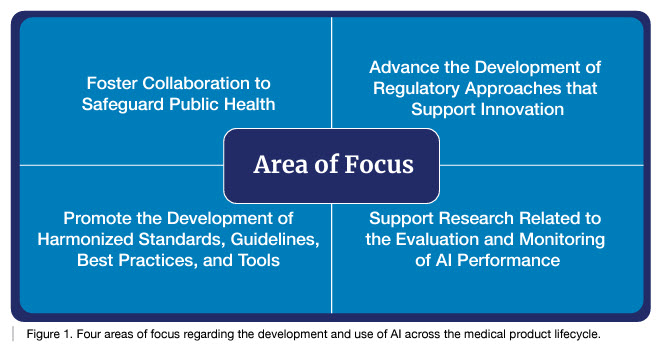FDA Publishes New Artificial Intelligence & Medical Products White Paper
On March 15, the United States Food & Drug Administration published a white paper entitled “Artificial Intelligence & Medical Products: How CBER, CDER, CDRH, and OCP are Working Together.” FDA announced the paper by sharing a short letter from Commissioner Califf, where he reaffirmed the Agency’s commitment to “promoting the responsible and ethical development, deployment, use, and maintenance of safe and effective medical products that incorporate or are developed with AI.” The white paper does not contain any new pronouncements of FDA position, but refers to existing guidance and serves as a reinforcement for existing FDA policy regarding AI.
That said, a couple of things caught our eye:
- Timing of the paper. The Commissioner’s letter and cross-center white paper follow closely on the heels of EU’s March 13 parliamentary approval of the AI Act, triggering implementation of an expansive regulation which the EU government itself claims establishes Europe as a global leader in the field of AI. Competition with foreign regulators continues to be a publication motivator for senior leaders in the executive branch, including FDA.
- Formally looping the Office of Combination Products into the publishing collaborative. Perhaps a tacit acknowledgment that the paramount issue facing FDA regarding operationalizing its oversight of AI in the medical products arena is product jurisdiction as between CDER/CBER and CDRH.
- In a footnote on the first page, FDA points out a distinction between typical AI use in drugs vs. devices that is, at once, patently obvious and unexpectedly clarifying. “The use of AI in the medical product life cycle for the development of drugs, biological products, devices, or combination products may differ. For example, for drugs and biological products, the end product is typically the drug or biological product itself, which will generally not include AI in that end product. For devices, the end product is the device, which may itself be AI-enabled.”
- Food is omitted from the conversation. The introduction letter is framed solely through a medical product lens and the paper, too, is a product of collaboration between medical product centers, CDER, CBER, CDRH and the Office of Combination Products. We continue to see FDA maneuvering itself into a position where a no-fault divorce of the foods regulatory oversight program from the medical product components seems feasible, along with a smooth transition and orderly incorporation of the human foods program into another agency.

Image source: FDA
The material contained in this communication is informational, general in nature and does not constitute legal advice. The material contained in this communication should not be relied upon or used without consulting a lawyer to consider your specific circumstances. This communication was published on the date specified and may not include any changes in the topics, laws, rules or regulations covered. Receipt of this communication does not establish an attorney-client relationship. In some jurisdictions, this communication may be considered attorney advertising.



